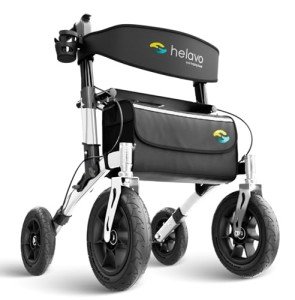10 Things We Are Hateful About Stable 4-Wheel Walker
The Stability of 4-Wheel Walkers: A Comprehensive Guide
A stable 4-wheel walker can change mobility for people experiencing challenges with balance and coordination. These gadgets, frequently called rollators, can be necessary tools in restoring self-reliance for those recuperating from surgical treatment, getting rid of age-related restrictions, or handling chronic conditions. This blog site dives into the features, advantages, and considerations one should keep in mind when selecting a 4-wheel walker, supplemented with useful tables and a Frequently Asked Questions (FAQ) section to enhance understanding.
Why Choose a 4-Wheel Walker?
A 4-wheel walker offers numerous benefits over conventional walking help, such as canes or walkers with just two wheels. Below are some of the key advantages:
Benefits of a 4-Wheel Walker
Advantage
Description
Enhanced Stability
The four wheels provide a stable base, enabling much easier navigation across various surfaces.
Improved Mobility
The models are normally lighter and much easier to maneuver, permitting users to move with self-confidence.
Integrated Sit-Down Feature
Lots of 4-wheel walkers included a built-in seat, offering users the choice to rest when needed.
Storage Options
Many walkers consist of storage bags or baskets for personal products, increasing flexibility for users.
Adjustable Height
Many models offer height changes to accommodate various user heights, offering comfort during usage.
Braking System
A lot of walkers come geared up with hand brakes, permitting the user to safely stop and lock the walker in location.
Kinds Of 4-Wheel Walkers
4-wheel walkers been available in numerous designs and functionalities to accommodate various user requirements. Below is a classified table:
Type
Description
Requirement Rollators
Fundamental designs designed for basic mobility. Frequently lightweight and foldable.
Heavy-Duty Rollators
Models constructed to support larger weights (approximately 500 lbs or more). My Mobility Scooters for heavier users.
Dual Brake Rollators
Deal both hand brakes and parking brakes for enhanced safety, especially helpful for elderly users.
Folding Walkers
Compact models that quickly fold for transport and storage. Perfect for those who take a trip or have actually limited area.
Specialized Rollators
Equipped with special features such as integrated lights, wider seats, or specific designs for particular conditions like arthritis.
Key Features to Consider
When picking a stable 4-wheel walker, it is vital to select a model that fits the user's requirements. Here are some important features to think about:
- Weight Capacity: Always check the maximum weight limitation.
- Height Adjustability: Ensure that it can be gotten used to suit the user's height.
- Wheel Size: Larger wheels provide better capability over rough terrains, while smaller wheels are excellent for indoor use.
- Seat Height and Comfort: If the model includes a seat, check its height and cushioning.
- Braking Mechanism: Look for reliable brakes that are easy to operate.
- Relieve of Folding: Users need to easily fold and unfold the walker for transport.
- Storage Solutions: Evaluate storage options like seat pouches and under-seat baskets.
- Material and Durability: Consider walkers made with durable products to guarantee longevity.
Popular Models on the Market
Here's a choice of popular designs presently available, showcasing their unique features and requirements:
Model
Weight Capacity
Seat Height
Features
Drive Medical Nitro
300 lbs
23.5”
Lightweight, easy-to-fold design, large wheels.
Medline Ultralight
300 lbs
23”
Integrated seat, adjustable manages, storage pouch.
Nova Zoom 4
300 lbs
22-24”
Dual brakes, padded seat, easy to fold.
INFANT JOY 4-Wheel
300 lbs
20-23”
Lightweight aluminum frame, storage basket, ergonomic manages.
How to Use a 4-Wheel Walker
Learning how to utilize a 4-wheel walker effectively is necessary for taking full advantage of security and mobility. Here's a step-by-step guide:
- Position the Walker: Stand behind the walker, with the handlebars at hip height.
- Adjust for Comfort: Make sure the height fits your comfort for standing and walking.
- Engage Brakes: Before sitting, engage the brakes to guarantee the walker does stagnate.
- Step Forward: Move the walker forward, guaranteeing all four wheels are in contact with the ground.
- Stroll Naturally: Use a natural walking rhythm, moving the walker forward and stepping the mechanism as needed.
- Rest: When fatigued, locate a seat on the walker, engage the brakes, and sit comfortably.
FREQUENTLY ASKED QUESTION
1. What is the perfect height for a 4-wheel walker?
- The handlebars must be at waist level when the individual is standing straight. The majority of walkers provide adjustable heights to accommodate this.
2. Can a 4-wheel walker be used outdoors?
- Yes, lots of designs are created for outdoor use, featuring larger wheels for much better navigation over uneven terrains.
3. How do you maintain a 4-wheel walker?
- Routinely inspect the wheels, brakes, and frame for wear and tear. Tidy surface areas to get rid of particles, and ensure the brakes operate properly.
4. Exist insurance benefits for acquiring a 4-wheel walker?
- Lots of insurance plans cover walkers if recommended by a healthcare company. Constantly check your specific plan details.
5. What is the average expense of a 4-wheel walker?
- Costs might differ extensively, from approximately ₤ 50 for standard models to over ₤ 300 for advanced designs.
A stable 4-wheel walker can considerably contribute to a person's mobility, self-confidence, and quality of life. By thinking about the features, types, and perfect usage techniques talked about above, individuals can make educated decisions that best suit their needs. Whether it's for recovery, aging, or handling continuous health conditions, picking the best walker can cause a much healthier and more active lifestyle.
